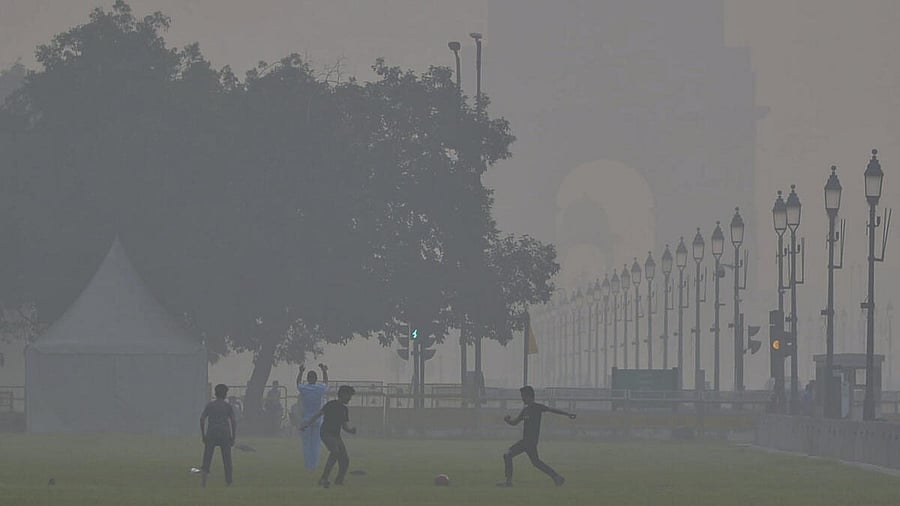
Children playing football near India Gate in New Delhi as smog engulfs the area.
Credit: PTI Photo
Delhi continues to be wrapped in a thick blanket of smog as air pollution is showing no signs of abating.
On Monday, the air quality in the national capital was in the 'severe' category, with the air quality index reading of 293 at 11 am, according to the portal AQI that monitors real-time PM2.5 and PM10 levels. The air quality has remained either in the 'severe' or 'very poor' category for several days now.
People in Delhi NCR have been waking up to a thick layer of smog and haze-filled skyline for the last couple of weeks, and the days during and after Deepavali saw the problem worsening, thanks to firecracker residue.
According to experts, pollutants are being trapped close to the ground owing to a combination of reasons such as vehicular emissions, stubble burning in neighbouring States and low wind speed.
Stage II of the Graded Response Action Plan (GRAP) to control air pollution is in force in Delhi. Latest steps taken by the authorities include a ban on non-BS-VI commercial vehicles from entering the city (effective from November 1), intensified dust control measures like the deployment of new mechanical sweepers and anti-smog guns, and a pilot cloud-seeding project. Also, the New Delhi Municipal Council has doubled parking fees across the city to discourage the use of private vehicles and encourage people to switch to public transport.
Air pollution continues to be Delhi's biggest health threat. According to an analysis by the Institute for Health Metrics and Evaluation (IHME), ambient particulate matter pollution was linked to 17,188 deaths, accounting for 15% of all fatalities in Delhi in 2023.
Over a decade ago, the situation was similar in China's capital, Beijing. In 2013, Beijing’s air pollution was referred to as an 'airpocalypse'. Beijing, which was dubbed the smog capital of the world, used to see thousands of deaths every year owing to air pollution.
In 2013, Beijing launched a $100 billion, multi-year strategy to clean its air. The targeted strategy, which included steps like shutting down polluting factories, curbing the use of charcoal for heating and prioritising electric vehicles, led to substantial declines in major pollutants and brought down the number of premature deaths due to air pollution.
Here is what Delhi can learn from Beijing to bring down air pollution.
Have a coordinated, long-term action plan with the bordering States, which also contribute to the capital’s pollution through stubble burning.
Shut down polluting industries, promote renewable energy and natural gas, and enforce strict industrial and car emission regulations. Address all sources of pollution, such as vehicle emissions, garbage burning, and construction dust, instead of depending on temporary solutions.
Modernise the public transport system, encourage electric vehicles (EVs), and restrict the use of private vehicles with a higher parking fee. Though Delhi authorities are implementing some of these measures, they should be part of a long-term plan and not just reactionary steps only when the air quality worsens.
Delhi also needs to improve its air quality monitoring by adopting a strategy similar to Beijing's, which involves strengthening regional coordination.
